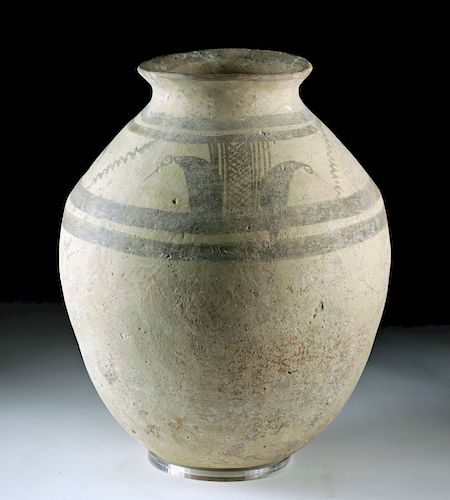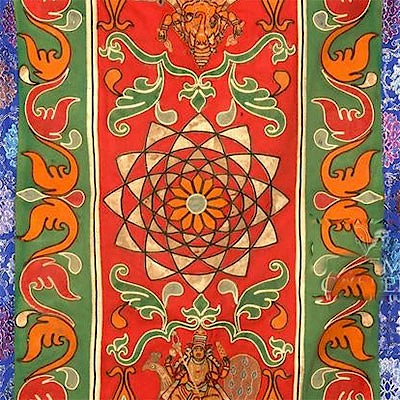Tall Ancient Tepe Giyan Pottery Vessel w/ Birds
Lot 211
About Seller
Artemis Gallery
686 S Taylor Ave, Ste 106
Louisville, CO 80027
United States
Selling antiquities, ancient and ethnographic art online since 1993, Artemis Gallery specializes in Classical Antiquities (Egyptian, Greek, Roman, Near Eastern), Asian, Pre-Columbian, African / Tribal / Oceanographic art. Our extensive inventory includes pottery, stone, metal, wood, glass and textil...Read more
Estimate:
$2,000 - $3,000
Absentee vs Live bid
Two ways to bid:
- Leave a max absentee bid and the platform will bid on your behalf up to your maximum bid during the live auction.
- Bid live during the auction and your bids will be submitted real-time to the auctioneer.
Bid Increments
| Price | Bid Increment |
|---|---|
| $0 | $25 |
| $300 | $50 |
| $1,000 | $100 |
| $2,000 | $250 |
| $5,000 | $500 |
| $10,000 | $1,000 |
| $20,000 | $2,500 |
| $50,000 | $5,000 |
| $100,000 | $10,000 |
| $200,000 | $20,000 |
About Auction
By Artemis Gallery
Oct 17, 2019
Set Reminder
2019-10-17 10:00:00
2019-10-17 10:00:00
America/New_York
Bidsquare
Bidsquare : Early Fall Variety | Ancient & Ethnographic
https://www.bidsquare.com/auctions/artemis-gallery/early-fall-variety-ancient-ethnographic-4538
Discover incredible lots relisted with new, lower start prices (up to 50% less), plus many items brand-new to auction. Step back in time and around the world – you’ll be amazed at the treasures you will find. Antiquities from the Classics, Asian, Pre-Columbian African and much more! Artemis Gallery info@artemisgallery.com
Discover incredible lots relisted with new, lower start prices (up to 50% less), plus many items brand-new to auction. Step back in time and around the world – you’ll be amazed at the treasures you will find. Antiquities from the Classics, Asian, Pre-Columbian African and much more! Artemis Gallery info@artemisgallery.com
- Lot Description
**Originally Listed At $1200**
Near East, Iran, Tepe Giyan, ca. 2800 to 1800 BCE. A rare form of bichrome earthenware jar with a large, bulbous body that tapers to a flat base and is corseted at the neck before widening into a flared rim. It is hand painted in dark brown hues on a tan buff ground with a stylized linear design from Tepe Giyan (a tepe or Persian tappeh, "hill" or "mound") around its broad shoulder. The notable motif of the vessel is repeated three times: two birds, back to back, their bodies half-crescent forms and their small heads composed of a single dot for an eye and a long, needle-like beak. Giyan Tepe is an ancient, large archaeological mound site located in Lorestan province of western Persia. Excavations of Tepe Giyan first occurred in 1931-1932 sponsored by Musees Nationaux and the Ecole du Louvre under the directorship of George Contenau and Roman Ghirshman. Size: 9.75" W x 13" H (24.8 cm x 33 cm)
For similar examples, see "The World of Persian Pottery: Gluck Collection" (Tokyo, 1980)
Provenance: private southern California, USA collection, acquired in the 1970s to mid-1980s
All items legal to buy/sell under U.S. Statute covering cultural patrimony Code 2600, CHAPTER 14, and are guaranteed to be as described or your money back.
A Certificate of Authenticity will accompany all winning bids.
We ship worldwide and handle all shipping in-house for your convenience.
#141059Neck and shoulder are repaired and restored with some overpainting. Surface has wear commensurate with age. There are very fine root marks around the lower part of the body. Excellent preservation of motifs.Condition
- Shipping Info
-
All shipping is handled in-house for your convenience. Your invoice from Artemis Gallery will include shipping calculation instructions. If in doubt, please inquire BEFORE bidding for estimated shipping costs for individual items.
-
- Buyer's Premium



 EUR
EUR CAD
CAD AUD
AUD GBP
GBP MXN
MXN HKD
HKD CNY
CNY MYR
MYR SEK
SEK SGD
SGD CHF
CHF THB
THB
















